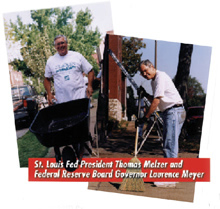Pieces of Eight: News Bulletins from the Eighth Federal Reserve District
From His Board to Ours
Members of the St. Louis Fed's board of directors—and their counterparts from the Little Rock, Louisville and Memphis Branch boards—met with a special visitor, Federal Reserve Chairman Alan Greenspan, at their Oct. 9 joint board meeting in St. Louis. Greenspan makes a point to visit the 12 Reserve Banks periodically both to hear firsthand reports from the directors on regional economic activity and to field their questions about monetary policy and related matters.
Greenspan's appearance at the joint board meeting underscores the important role of Reserve Bank directors. Like the 11 other regional Reserve Banks, the St. Louis Fed has a board that consists of nine members who oversee Bank operations and advise the Bank president on monetary policy. As with private-sector boards, the St. Louis board's responsibilities include: approving the Bank's plans and budgets; selecting the Bank's president and first vice president; approving senior-level officer appointments; and overseeing the Bank's audit function.
Two other key responsibilities relate to monetary policy. First, when conditions warrant, St. Louis directors recommend changes in the District's discount rate—the rate the Fed charges depository institutions for short-term loans—to the Federal Reserve Board of Governors. Second, directors at all four Eighth District offices—St. Louis and the three Branches—report on developments in their respective firms and industries, as well as general economic developments in their regions. This information not only helps Bank staff keep abreast of any shifts in economic activity, it also may be incorporated into the report, "Current Economic Conditions by Federal Reserve District," more commonly known as the Beige Book. The Beige Book, which is released two weeks prior to every Federal Open Market Committee (FOMC) meeting, is used by the FOMC during monetary policy deliberations as one gauge of the economy's strength.
 |
| St. Louis Fed President Thomas Melzer and Federal Reserve Board Governor Laurence Meyer |
Making Monetary Policy Seems Almost Easy Now
Federal Reserve Board Governor Laurence Meyer (right) and St. Louis Fed President Thomas Melzer (left) joined roughly 50 St. Louis Fed employees Oct. 4 at Block-Aid, a volunteer clean-up event sponsored by Neighborhood Housing Services of St. Louis.
The annual event is designed to stimulate revitalization in depressed city neighborhoods, like the Tower Grove East section, where the St. Louis Fed group, and many others, spent the day.
Melzer devoted his time to the front yard on one of the four houses the Fed was assigned to spruce up. Melzer's landscaping efforts were not, he noted tongue-in-cheek, "one of the new challenges" he was referring to in his recently submitted resignation letter to the St. Louis Fed's board of directors. (Melzer's resignation is effective Jan. 1, 1998.)
For his part, Meyer made sure that the house he was working on had the best coat of paint this side of the Mississippi, which is the side he used to live on before being appointed to the Board of Governors in June 1996.
The Block-Aid event was near and dear to Meyer's heart since he represents the Federal Reserve Board as a director of the Neighborhood Reinvestment Corporation, the parent organization of the 200-plus NHS agencies throughout the country. Meyer also chairs the Board's Committee on Consumer and Community Affairs.
Plentiful Producers
Percent of Nonfarm Employees in Manufacturing, 1996
| District State | Rank Among 50 States | % Nonfarm Employees |
|---|---|---|
| Indiana | 1 | 24.2 |
| Arkansas | 3 | 23.3 |
| Mississippi | 5 | 22.2 |
| Tennessee | 9 | 20.4 |
| Kentucky | 11 | 18.5 |
| Illinois | 18 | 17.1 |
| Missouri | 22 | 16.0 |
| National Average: | 15.2 |
SOURCE: U.S. Bureau of Labor Statistics
Views expressed in Regional Economist are not necessarily those of the St. Louis Fed or Federal Reserve System.
For the latest insights from our economists and other St. Louis Fed experts, visit On the Economy and subscribe.
Email Us

